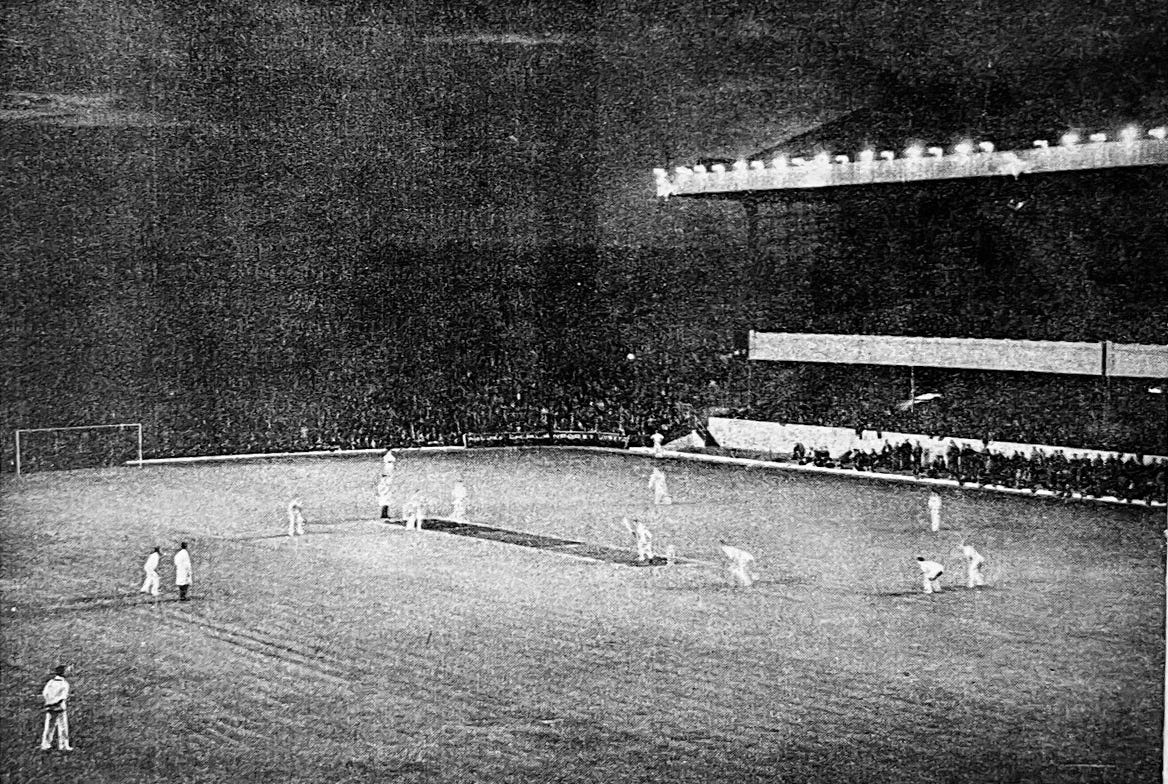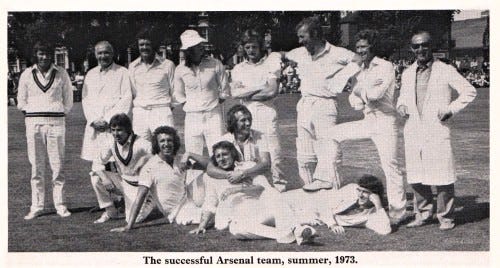In the 1990s, two sports dominated our free time: cricket and football. The months of March to May were cricket season, while the advent of the Indian monsoon meant that July to October was dedicated to football. My interest in the two sports has stayed with me to date.
Having written this article on foreign players who have featured in the Ranji Trophy, one name stood out: Denis Compton. Apart from batting on the turf of Lord’s, Compton was also a player at Arsenal FC.
As a supporter of the said club, I was compelled to dig deeper into Arsenal’s ties with cricket. The ties run deep - in fact, from the inception.

On October 4, 1886, members of Dial Square Cricket Club held a smoking concert. It was during this event that the decision was made to form a football team, and Dial Square Football Club would eventually become the club now known as The Arsenal.
The First Names
Though we’re unlikely to see a return of such multi-talented players, Arsenal boasted a wealth of cricketing ability between the 1930s and 1950s, with several players competing regularly for their counties.
Three Arsenal players, Wally Hardinge, Andy Ducat, and Arthur Milton, earned the rare distinction of representing England at the highest level in both football and cricket.
Hardinge uniquely represented England once in both sports: football in 1910 and cricket in 1921. Remarkably, he played for Kent until the age of 47. Ducat earned six England football caps and played once in the 1921 Ashes. He uniquely died at the crease at Lord’s while batting for the Surrey Home Guard in 1942.
An Arsenal youth product, Arthur Milton earned one England football cap in 1951 and represented England in six Test matches in the 1958–1959 season. He won the league in 1953.
Joe Hulme, a key figure in Arsenal’s 1930s dominance, winning four league titles and two FA Cups, earned nine England caps. George Cox was mostly a reserve at Arsenal, making seven appearances. He had a prolific cricket career, scoring 50 centuries for Sussex.
In August 1934, Hulme and Cox received permission to play for Middlesex and Sussex, respectively, provided they returned in time for the Highbury Reds vs Whites pre-season trial.
During the 1930s, the Evening News even organized a cricket tournament for London football clubs. Arsenal triumphed in 1931, 1932, and 1934, making them not only Football League champions but also winners of the Evening News Cricket Cup for Footballers.
Straight Outta Compton
Denis Compton stands at the center of any Arsenal cricket story. He played for Arsenal from 1936 to 1950 and Middlesex from 1936 to 1958, excelling as both a winger and a world-class batsman.
Though his England football appearances during World War II don’t count as full caps, he remains one of the greatest cricketers in English history. Between 1937 and 1957, Compton played 78 Tests and scored over 100 first-class centuries. His legendary 1947 season included 50 innings, 18 centuries, 3,816 runs, and an astonishing average of 90.85: many alongside his good friend Bill Edrich, who also scored over 3,500 runs and had played football for Spurs in the 1930s.
Compton played a key role in Arsenal’s 1947/48 league title and their 1950 FA Cup win- his penultimate appearance for the club. Though a recurring knee injury had him considering retirement after the war, managers George Allison and Tom Whittaker convinced him to carry on until Arsenal secured the Cup.
Despite World War II disrupting his career, Compton served in the Royal Artillery in India, where he managed to play 17 first-class matches. After the war, he also became the face of Brylcreem ads, thanks to his signature hairstyle.
In August 1949, Highbury hosted a benefit cricket match between Arsenal and Middlesex to honor Compton. With Denis and his brother, Leslie, in the Arsenal side, and guest appearances from Ted Drake and Hulme, Arsenal won by 29 runs.
Highbury staged similar benefit matches in 1952 and 1955 for Middlesex players Jack Young and Leslie Compton, respectively. In the 1955 match, Cliff Holton and Bill Edrich each scored centuries, though Middlesex emerged victorious.
Highbury Cricket Ground
Throughout the 1950s, Arsenal frequently played cricket matches, not only at Highbury but also at various venues shortly before the football season. One regular fixture was the Joe Levi Memorial Cup, played at Tufnell Park against Northern Polytechnic CC.
Joe Levi, a close associate of Herbert Chapman, had strong links with both Arsenal and the Polytechnic. His widow created the memorial cup with the support of Arsenal and Tom Whittaker. In the first match, Arsenal posted 220 before bowling out Northern Polytechnic for just 113, thanks to a devastating 20-9 spell from George Swindin.
Other notable games include a 1956 fixture in Horsmonden against Charlton FC, which featured many county cricketers. Arsenal fielded five players with first-class experience, Leslie Compton, Ray Swallow, Don Bennett, Don Roper, and Jim Standen, and beat Charlton by 53 runs, with Swallow top scoring at 64. A year later, Holton led Arsenal against Kent CCC in the same village. Though the Gunners fell short by six runs in a low-scoring game, they gave a good account of themselves.
As dual-code players became rarer after the 1950s, Arsenal’s involvement in cricket shifted toward charity matches. In 1973, Arsenal defeated Tottenham in a charity match at Finsbury Park, organized for the Woodberry Down Boys Club. John Radford and Charlie George opened the innings, Bob Wilson kept wicket, and Peter Storey, Peter Simpson, Alan Ball, Geoff Barnett, and Bob McNab all played. Bertie Mee and Spurs manager Bill Nicholson acted as umpires.
In the late 1980s, Arsenal played annual charity matches against the Kings Head Taverners from Winchmore Hill. After their dramatic 1988–89 title win, the team relaxed with a summer match. David Rocastle top-scored with 33, while Perry Groves and Tony Adams chipped in, helping Arsenal post 115-9. Despite Andy Cole’s 4-23, the Taverners’ batting lineup chased it down, winning by five wickets.
More recently, former youth player Ian ‘Gunner’ Gould transitioned into umpiring and rose to international prominence. Today, he ranks among the most respected cricket umpires in the world.
Finally, I would be remiss if I failed to mention the Hill-Wood family. The long-time custodians of the club also maintained strong ties with Derbyshire County Cricket Club from the Victorian era through to the swinging sixties.
Here’s a list of Arsenal first-team players who played cricket at county level:
Harry Storer (Arsenal 1894-1895 & Derbyshire 1895)
Charles McGibbon (Arsenal 1905-6/1910 & Hampshire 1919)
Andrew Ducat (Arsenal 1905-1912 & Surrey 1906-1931)
Wally Hardinge (Arsenal 1913-1921 & Kent 1902-1933)
Joe North (Arsenal 1919-1922 & Middlesex 1923-1927)
Henry White (Arsenal 1919-1923 & Warwickshire 1923)
Joe Hulme (Arsenal 1926-1938 & Middlesex 1929-1939)
George Cox (Arsenal 1933-1936 & Sussex 1931-1961)
Leslie Compton (Arsenal 1932-1952 & Middlesex 1938-1956)
Ted Drake (Arsenal 1934-1945 & Hampshire 1931-1936)
Denis Compton (Arsenal 1936-1950 & Middlesex 1936-1958)
Don Roper (Arsenal 1947-1957 & Hampshire 1947)
Arthur Milton (Arsenal 1950-1955 & Gloucestershire 1948-1974)
Jim Standen (Arsenal 1953-1960 & Worcester 1959-1970)
Ray Swallow (Arsenal 1955-1958 & Derbyshire 1959-1963)
Arsenal reserve/youth players who played for a County Cricket Club
Edwin Leaney (Arsenal 1890-1891 & Kent 1892)
Jimmy Gray (Arsenal 1947-1951 & Hampshire 1948-1966)
Brian Close (Arsenal 1950-1952 & Yorkshire/Somerset 1949-1977)
Don Bennett (Arsenal 1950-1959 & Middlesex 1950-1968)
Ian Gould (Arsenal 1971-1974 & Middlesex/Sussex 1975-1990)
Sources:
Why the hearts of Dial Square FC fans still sing for the club across town: BBC
Cricketing footballers – a history: Judd Street Tigers
Arthur Milton: Last of the Double Internationals: The Cricket Web
Gunners Who Could Bat And Bowl A Bit: Goonerholic






